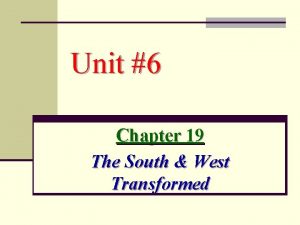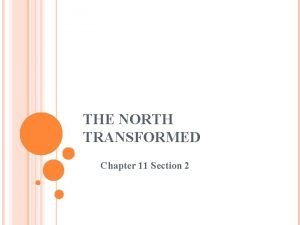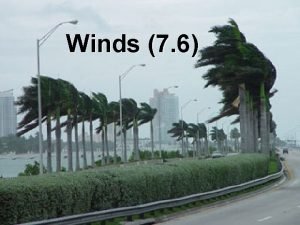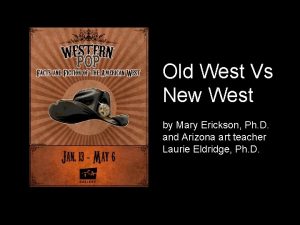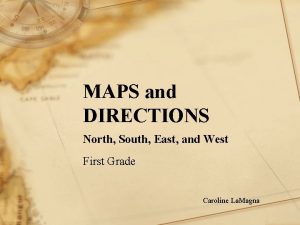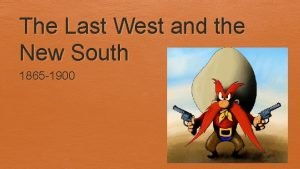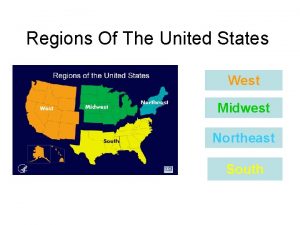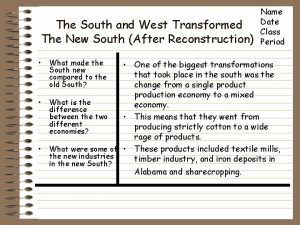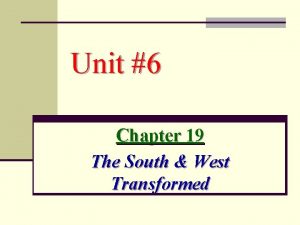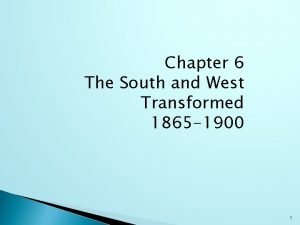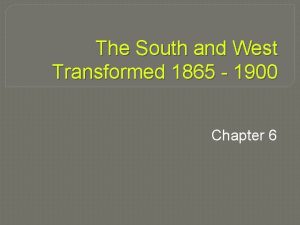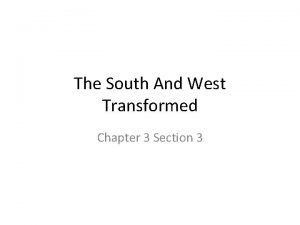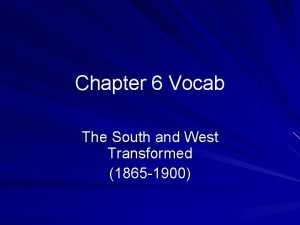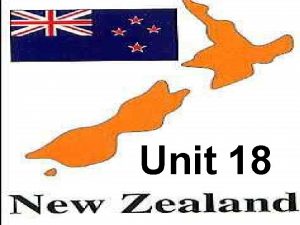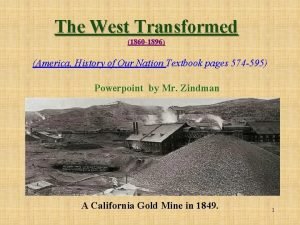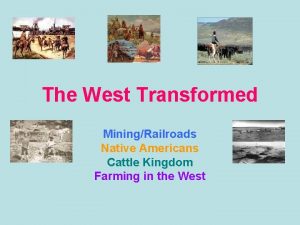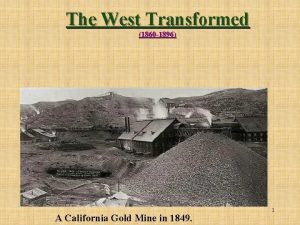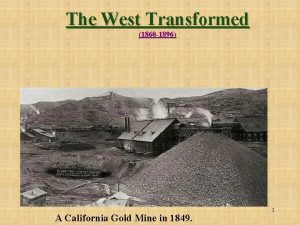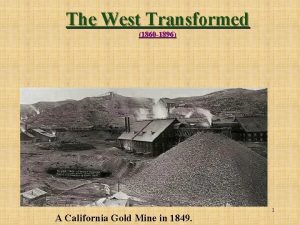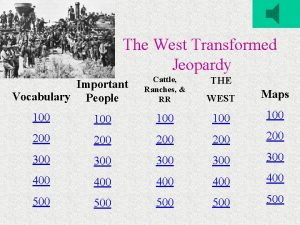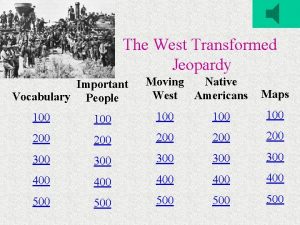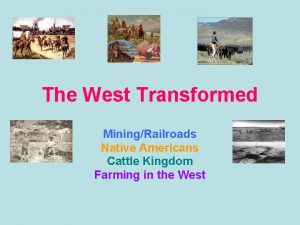Unit 6 Chapter 19 The South West Transformed




















- Slides: 20

Unit #6 Chapter 19 The South & West Transformed

II. The New West

A. Views of Western History § Geographically, the land was characterized by extremes (mountains, rivers, deserts, and dense forests), while the climate was primarily extreme dry in the Southwest to arid in the Great Plains to extreme wet Marine West Coast in the Northwest. § Settlers had to adapt to each climate (e. g. irrigation in the Plains). § Indians posed a problem in some areas as warfare

B. The Post-Civil War West Frontiers of Settlement § Following the end of the Civil War, many new settlers streamed west for various reasons. § The new group of settlers quickly changed the primarily Indian and Spanish culture of the West. Great American Desert § New techniques allowed these new settlers to the grow food in the desert (e. g. wells and irrigation canals).

C. Migration to the West Native-born Americans § The majority of settlers were middle-class whites who could afford the passage. Foreign Immigrants § Irish, German, Chinese, Mexican, and Scandinavians were the largest groups.

C. Migration to the West (Cont’d. . . ) Exodusters § Kansas and Oklahoma were the primary destinations for many blacks who migrated West. § A promoter of black migration was Benjamin “Pap” Singleton (a former slave) who established the Kansas community of Dunlop in 1878. § In 1866, Congress approved the establishment of black cavalry units (nicknamed “Buffalo Soldiers” by Indians) who helped map the West and subdue

C. Migration to the West (Cont’d. . . ) “Buffalo Soldiers”

D. The Mining Frontier Pattern of Mining Development § The pattern of the “Forty-niners” continued for the next three decades as new prospectors came West as lawlessness gave way to orderly communities. Location of Major Mineral Discoveries § California § Colorado § Nevada

D. The Mining Frontier (Cont’d. . . ) Mining & the Environment § Mass Production (corporations used hydraulic mining) changed the landscape of the region. § Protests from farmers downstream led to the formation of private militias before the farmers turned to the courts. § Woodruff v. North Bloomfield, 1884 was a federal case which ruled that miners could not dump debris which could reach farmland thus becoming the first major

E. Displacement of the Indians Agreement for Tribal Limitations, 1851 § Treaty of Fort Laramie (Wyoming Territory). Conflicts during the Civil War § Sand Creek Massacre, 1864. Establishment of the Indian Peace Commission at Medicine Lodge, Kansas (1867) § Policy of two large reservations in Oklahoma (Indian

E. Displacement of the Indians (Cont’d. . . ) Sand Creek Massacre (1864)

E. Displacement of the Indians (Cont’d. . . ) Continued Resistance if Indians § Red River War (1874— 1875) § The Great Sioux War (1874— 1876) § Massacre at the Little Bighorn (June, 1876) § Conquest of Sioux § Significance of Chief Joseph and Nez Perce § Ghost Dance Movement § Dawes general Allotment Act of 1887

E. Displacement of the Indians (Cont’d. . . ) Red River War (1874— 1875) § White buffalo hunters entered Indian hunting grounds and touched-off a series of minor and major incidents near the Red River in western Texas. § The result was an end to the southern buffalo herds and the opening of the Texas panhandle to White settlement.

E. Displacement of the Indians (Cont’d. . . ) Fighting in the Black Hills (1875— 1876) § The Black Hills Gold Rush led an influx of White settlers to the Dakota Territory and Sioux hunting grounds. § The Sioux (led by Crazy Horse and Sitting Bull) assembled thousands of warriors to drive out the settlers raiding towns and settlements. § Once again, the federal government sent cavalry and

E. Displacement of the Indians (Cont’d. . . ) Sitting Bull Crazy Horse

E. Displacement of the Indians (Cont’d. . . ) Fighting in the Black Hills (1875— 1876)

E. Displacement of the Indians (Cont’d. . . ) Battle of the Little Big Horn (June, 1876) § Colonel George Armstrong Custer (a former Union officer) was sent to meet a large group of Sioux near the Little Big Horn River, Montana. § Custer divided his forces and was surprised by nearly 2, 000 warriors led by Crazy Horse. § The result of the battle was the death of Custer and his 250 men. § In addition, cried for revenge motivated other federal units to track down Crazy Horse and Sitting Bull.

E. Displacement of the Indians (Cont’d. . . ) Battle of the Little Big Horn (June, 1876) Custer’s “Last Stand” Lt. Colonel George Armstrong Custer

E. Displacement of the Indians (Cont’d. . . ) Chief Joseph & the Nez Percés Relocation (1877) § When the federal government decided to remove the Nez Percés of Idaho to Oklahoma, their leader, Chief Joseph, decided to march his people nearly 1, 200 miles to Canada. § The trek was stopped as federal troops seized Chief Joseph and his people.

E. Displacement of the Indians (Cont’d. . . ) Ghost Dance War (1889— 1890) § A religious revival of Native Americans which was thought to bring back the buffalo and end White rule in the West. § As a result of renewed resistance (which was caused by the Ghost Dance), conflict occurred in the
 The south and west transformed
The south and west transformed The north transformed
The north transformed West north west wind direction
West north west wind direction What creates wind
What creates wind Noord zuid west oost
Noord zuid west oost East is east and west is west
East is east and west is west Old west vs new west
Old west vs new west South west asia and north africa map
South west asia and north africa map Maps.google.comps
Maps.google.comps Lines that run east and west but measure north and south
Lines that run east and west but measure north and south Fifty nifty united states
Fifty nifty united states North south east west in our calm objective opinion
North south east west in our calm objective opinion The last west and the new south
The last west and the new south South west asia
South west asia South west london health and care partnership
South west london health and care partnership West midwest south northeast
West midwest south northeast North south east west leadership styles
North south east west leadership styles Cathedral 50 miles south west of paris completed in 1220
Cathedral 50 miles south west of paris completed in 1220 North east south west
North east south west D i e t, south-west, ghumman hera, new delhi-110073
D i e t, south-west, ghumman hera, new delhi-110073 North, south east west leadership styles
North, south east west leadership styles
